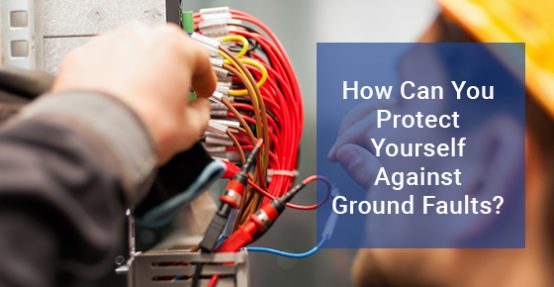
Electrical accidents that cause electrocution are quite common at home and at work. Every year they cause thousands of injuries and hundreds of deaths in the country, yet electrocutions are largely preventable with proper ground fault protection.
Ground faults occur when the current in a live electrical circuit is redirected to the ground rather than taking the intended path back to the panel.
People get electrocuted when they accidentally touch ‘live’ exposed electrical wires or other exposed metal parts connected to high-voltage equipment and appliances.
Most electrical equipment is fitted with fuses to automatically disconnect the current in the event of excessive currents. But they do not offer any protection when normal current is passing through an exposed wire or metal part.
Instead, electric appliances use ‘ground’ or ‘earth’ cables, which is the third wire beside the live and neutral wires in your standard cord that connects the exposed metal part of the equipment to the earth via a metal pipe or household wiring.
With ground electronic equipment, in the event that an exposed part of a live cable comes in contact with any metallic parts, the current will be safely carried away to the earth through the ground cable.
That said, it is possible for the ground or earth cable to fail as well, like if the cable gets cut. In such cases, your electrical contractor will have other safety measures in place, such as the use of protective devices like ground fault circuit interrupters (GFCIs) or residual current devices (RCDs) that automatically shut off any stray current before they cause electrocution, electric fires, and other electrical accidents.
Ground fault circuit interrupters (GFCIs) protect you from electric faults regardless of whether or not the wiring is grounded. They help to prevent electrocution by tripping within 1/40th of a second when a current leakage in the range of 4 to 6 milliamps is detected.
According to the Ontario Electrical Safety Code, GFCIs and breakers should be fitted on outlets in wet areas like bathrooms, kitchens, and outdoor areas including hot tubs and pools by a certified electrical contractor. They are also fitted in outlets in basements, garages, and outdoor areas, and other wet areas where the outlet is within 4-6 feet from a sink.
GFCIs are designed to constantly monitor and compare the amount of current passing through a device and returning along the electrical path. They function as fast-acting circuit breakers, tripping the instant a difference of 5 milliamps is detected. They can disconnect power in1/40th of a second, helping to protect you from electrocution.
For a properly grounded electrical system, a ground fault would cause the current to flow:
The amount of current that is redirected through the ground fault protection system depends on the impedance between the ground return path distribution system and alternative parallel paths.
Ground fault protection is typically integrated into GFCI circuit breakers or GFCI receptacles for installation into the distribution system, though there are some portable GFCIs that allow for on-the-spot ground fault protection when it’s not installed on the circuit.
GFCI receptacles are the most common and feature a flat face with little black and red buttons between the plug slots. The receptacle can be wired to either protect a single receptacle or protect itself and other receptacles and devices located along the same circuit.
GFCI breakers, on the other hand, ensure ground fault protection for all receptacles and devices connected to the circuit.
Keep in mind that GFCI protection is different from electrical grounding. For a GFCI to function, it doesn’t need to be installed in a grounded circuit. Installing GFCI on a non-grounded circuit cannot provide equipment ground or a true ground for that matter. This, in turn, prevents surge protectors that need a ground from performing their job.
Any devices or receptacles that feature GFCI protection on an ungrounded circuit must carry a visible label showing that the equipment has no ground. The labels are fitted as stickers on new GFCI receptacles.
Compared to grounded electrical systems, ungrounded circuits face the risk of transient overvoltage. An arcing or intermittent ground fault may lead to the accumulation of voltage on the system, causing stress and insulation deterioration that may ultimately cause a surge in voltages that reach 6 times the nominal equipment voltage.
Ungrounded circuits are also difficult to locate a ground fault because they don’t let ground-fault currents through on the first fault. Instead, they minimize the voltage on the faulted phase in the entire distribution system.
With grounded systems, the exact location of the fault can be found using current-based ground-fault relays. These faults can be in the form of:
Since currents must return to its origin, ground-fault relays can monitor phase conductors to detect whether all the current released also returns, or read the current between the transformer neutral and ground for any irregularities.
There are some instances when your ground-fault relay trips accidentally. This usually occurs due to harmonics and higher-frequency electrical noise, which is associated with the use of variable frequency drives, LED lighting, inverters, and battery storage, causing the GFCI to detect fault current.
Fortunately, accidental trips can be prevented by choosing a premium-quality ground-fault relay with the capability to isolate harmonic frequencies and other types of noise from its current measurements.
Considering that ground faults typically occur due to unintended contact with live electrical parts from defective or damaged equipment, you should schedule regular inspections of your electrical appliances and wiring, especially in older homes to ensure proper ground fault protection and eliminate the risk of severe shocks, electrocution, or fires.
To learn more about how to protect yourself from ground faults, call Hi-Lite Electrical at 416-800-5536 or contact us here.
© 2023 Licensed Electrical Installation & Service – Hi-Liteelectricinc.ca
All Rights Reserved.
Leave A Comment